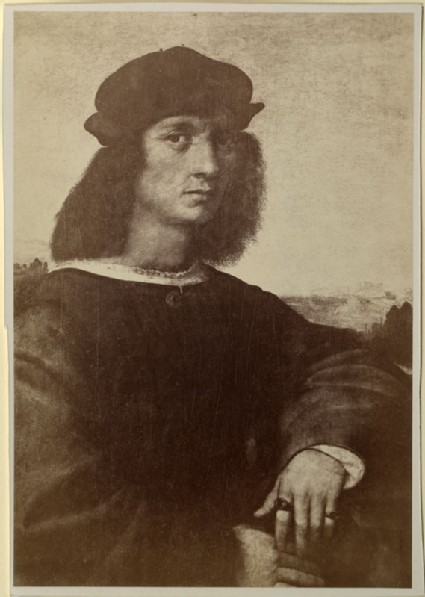Browse: 1470 objects
- Reference URL
Actions
Photograph of Raphael's "Portrait of Agnolo Doni" Anonymous Italian
-
Curator’s description:
Description
The Florentine banker Agnolo Doni is shown half-length, facing three-quarters to the right. An open landscape can be seen over both his shoulders, with open sky above.
Cook and Wedderburn (XXI.24 n. 3) correctly identify this as Raphael's portrait of Agnolo Doni, painted in Florence - together with a matching portrait of his young wife Maddalena - around 1507 or 1508, just before Raphael left for Rome. Both portraits are now in the Pitti Palace in Florence.
The photograph is first recorded in the Teaching Collection in the "Catalogue of Examples" of 1870, when Ruskin listed it in frame no. 36 of the Standard Series, below a photograph the portrait of a man, now attributed to Jacopo de' Barbari but which Ruskin believed was by Mantegna; both works retained their positions in the 1872 catalogue of series.
In his catalogue entry, Ruskin compared this painting with the portrait by ...; Raphael's was superfically more attractive, the other 'far the finest work' on account of the quality and minuteness of its workmanship.
-
Details
- Artist/maker
-
Anonymous Italian (Anonymous, Italian) (photographer)after Raphael (1483 - 1520)
- Object type
- photograph
- Material and technique
- albumen print
- Dimensions
- 222 x 154 mm (print); 230 x 162 mm (original mount)
- Inscription
- On the back of the mount:
towards bottom left, in graphite: St 36 lower
just above, the Ruskin School's stamp
- Provenance
-
Presented by John Ruskin to the Ruskin Drawing School (University of Oxford), 1875; transferred from the Ruskin Drawing School to the Ashmolean Museum, c.1949.
- No. of items
- 1
- Accession no.
- WA.RS.STD.036.b
-
Subject terms allocated by curators:
Subjects
-
References in which this object is cited include:
References
Ruskin, John, Catalogue of Examples Arranged for Elementary Study in the University Galleries (Oxford: Clarendon Press, 1870), cat. Standard no. 36
Ruskin, John, Catalogue of the Reference Series Including Temporarily the First Section of the Standard Series (London: Smith, Elder, [1872]), cat. Standard no. 36
Ruskin, John, ‘The Ruskin Art Collection at Oxford: Catalogues, Notes and Instructions’, Edward T. Cook and Alexander Wedderburn, eds, The Works of John Ruskin: Library Edition, 39 (London: George Allen, 1903-1912), 21, cat. Standard no. 36
Location
-
- Western Art Print Room
Position in Ruskin’s Collection
Ruskin's Catalogues
-
Ruskin's Standard & Reference series (1872)
36. Portrait (I believe the person is unknown) by Mantegna. Portrait by Raphael.The uppermost of these two is far the finest work, though the superficial qualities of Raphael’s are more attractive.
Mantegna’s may be taken as a perfect type of the schools of delineation in Italy; and cannot, in workmanship, be surpassed. Note especially the treatment of the hair, which is drawn with the precision of Dürer, yet the breadth of Titian: and, with respect to the execution of these details by the masters of the fifteenth century, as well as to the method of early practice in drawing with the brush, which I wish you to pursue yourselves, read the following extract from Mrs. Heaton’s Life of Dürer:—
Camerarius relates a pretty little anecdote apropos of the visit of Giovanni Bellini to our artist, which he probably learnt from Dürer’s own lips. He says that Giovanni, on seeing Dürer’s works, was particularly struck with the fineness and beautiful painting of the hair in them, and asked Dürer as a particular mark of friendship, to give him the brush wherewith he executed such marvellously fine work. Dürer offered him a number of brushes of all sorts, and told him to choose which he preferred, or, if he liked, he was welcome to take them all. Giovanni, thinking that Dürer had not understood him, again explained that he only wanted the particular brush with which he was accustomed to paint such long and fine parallel strokes; whereupon Dürer took up one of the ordinary brushes, such as he had offered to Bellini, and proceeded to paint a long and fine tress of woman’s hair, thereby convincing Bellini that it was the painter, and not the brush, that did the work. Bellini avowed afterwards that he would not have believed it possible, had he not seen it with his own eyes. See farther the notes on Edu. 50.





